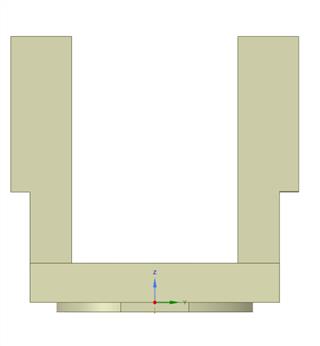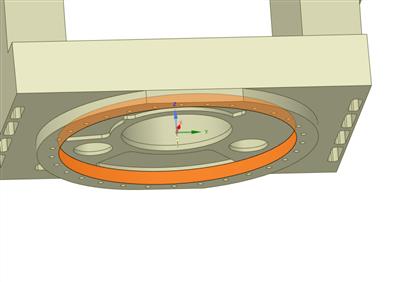-
-
March 2, 2020 at 11:19 am
Ozan.
SubscriberHi everyone,
I would like to run a transient analysis with half sine function. Also when I try to insert the earth gravity into my system mechanical won't let me to do it. Is there anyway the apply earth gravity into my system ? I couldn't get the theory of half sine waveform.
-
March 2, 2020 at 1:07 pm
peteroznewman
SubscriberIf you want gravity to pull objects in the -Y direction, you must apply an Inertial Acceleration load in the +Y direction of 9.8 m/s^2.
What is the amplitude (with units) and duration of your half sine?
-
March 2, 2020 at 1:21 pm
Ozan.
SubscriberI just used this formula to calculate amplitude - 20*9806*sin(2*pi*(1/20.013))*time Units:Radian
-
March 2, 2020 at 1:26 pm
Ozan.
SubscriberSir are you saying when we apply half-sine waveform we can not use standart earth gravity. Am i correct ? Is that happenning because of half-sine theory or anything else different ?
Because when the acceleration loads would be the constant value such as 20G etc. , there will be no problem. Only differences between both of them is acc. value. One of it constant one of it function.
-
March 2, 2020 at 1:32 pm
Ozan.
SubscriberSorry for texting one by one but I just curioused about one more thing. When we decided to run transient with half-sine function, should we link the transient to a modal solution ?
-
March 2, 2020 at 1:39 pm
peteroznewman
SubscriberThere are no radians in a half-sine transient pulse.
The base units are length, and time. I'll give you a hint, the units of time are seconds.
What are the units of the amplitude of the half-sine? Is it Displacement, Velocity or Acceleration?
Please reply with a sketch of the half-sine and show the value of the height and width (with units).
-
March 2, 2020 at 1:50 pm
-
March 2, 2020 at 2:05 pm
peteroznewman
SubscriberI see the acceleration half-sine is in the Z direction. What direction is earth gravity?
Please insert an image of the structure and show the face that is fixed to ground, and make sure the coordinate triad is visible in the image.
-
March 2, 2020 at 2:50 pm
Ozan.
Subscriber -
March 2, 2020 at 7:24 pm
peteroznewman
SubscriberI see, it is like a tuning fork. You should definitely run the modal solution first. What is the first natural frequency? How does that compare with the frequency of your half sine, which at 13 ms is a 38.5 Hz forcing frequency (among others). If you have a Modal analysis and link the solution of the Modal into the Setup cell of the Transient Structural, you will be making it a linear analysis, which is good to do for a first evaluation.
-
March 2, 2020 at 8:33 pm
Ozan.
SubscriberSo according to my understanding, we should always first run modal analysis for the transient with half-sine waveform. Or which you have mentioned above about modal analysis only valid for this case? -
March 3, 2020 at 12:34 am
peteroznewman
SubscriberAlways look at Modal analysis results as the first step for any dynamics model.
Start a Transient Structural analysis using modal superposition (MSUP) because with the linear analysis, you will get results faster.
After you review the MSUP results, you may decide to run a Full Transient without MSUP.
-
March 3, 2020 at 5:42 am
Ozan.
SubscriberDue to MSUP results what is the criteria for the run full transient ?
-
March 3, 2020 at 12:37 pm
peteroznewman
SubscriberMSUP Transient Structural is a linear analysis, which means it includes a small displacement assumption. If the displacements are large, that is one reason to run a full transient.
Linear models can't have nonlinear material behavior, so if the stress exceeded the yield strength and you want to include plasticity in the material model, that is another reason to run full transient.
Linear models can't have nonlinear contact (frictionless, frictional, rough), so if faces are penetrating in the linear model, you can add nonlinear contact to prevent that from happening in the full transient.
-
March 3, 2020 at 2:13 pm
Ozan.
SubscriberThank you for informations. I'm appreciate for your attention Peter. I'm going to work on my model according to your advices.
-
March 3, 2020 at 7:53 pm
peteroznewman
SubscriberOkay, please mark a reply with Is Solution (while logged in) to mark this discussion as Solved. Open a New Discussion for any new questions. Good Luck!
-
- The topic ‘Half-Sine Shock / Earth Gravity’ is closed to new replies.


- The legend values are not changing.
- LPBF Simulation of dissimilar materials in ANSYS mechanical (Thermal Transient)
- Convergence error in modal analysis
- APDL, memory, solid
- How to model a bimodular material in Mechanical
- Meaning of the error
- Simulate a fan on the end of shaft
- Real Life Example of a non-symmetric eigenvalue problem
- Nonlinear load cases combinations
- How can the results of Pressures and Motions for all elements be obtained?

-
4047
-
1472
-
1308
-
1156
-
1021

© 2025 Copyright ANSYS, Inc. All rights reserved.












